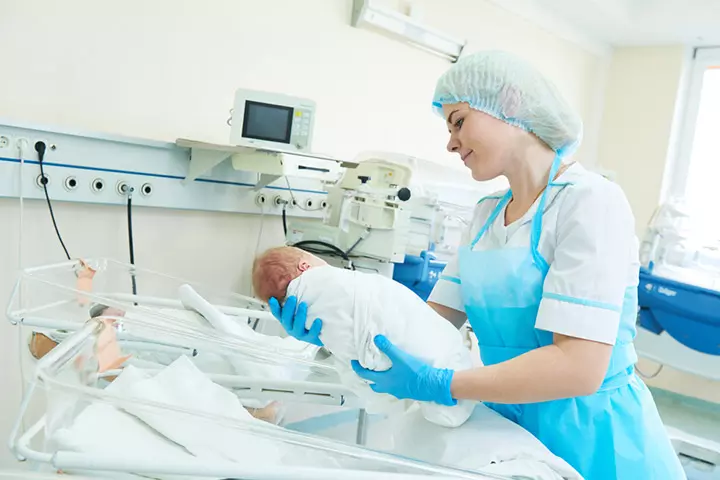

Image: Shutterstock
Our body acts as a host to a multitude of microorganisms which includes bacteria, fungi, viruses, and archaea. In fact, only 43% of the human body is made up of human cells, the rest being microscopic colonists. Our bowels are a prime location for many of these microbes, especially bacteria. Group B Strep is one such strain of bacteria that are naturally present in our bodies. In many, Group B Strep lives on the surface of the intestines harmlessly. But if the bacteria find their way inside the organs, they can cause infection and associated diseases. Babies are at particular risk of getting infected with the Group B Strep from their mothers. Let’s dive in and get to know more about this bacteria:
1. What Is Group B Strep?
Image: Shutterstock
Group B Strep, also known as Group B Streptococcus or Beta Strep, is a kind of bacteria that lives within the human body, particularly in the intestines. They are commonly found in the gastrointestinal and genital tracts. The gastrointestinal tract includes the stomach and intestines where food gets digested. The genital tract in women includes the vagina and related reproductive organs. It’s normal to have this virus present in your body without suffering from any disease or related health risks. However, when they enter the bloodstream or the organs, they can cause inflammations and infections causing serious ailments which would require medical intervention (1).
Group B Strep infections can be severe in both adults and babies, but more so in the latter. Sometimes, Group B Strep in newborns can lead to meningitis, pneumonia, and even sepsis. Pregnant women will have to be particularly wary of Group B Strep, as it can cause severe infections in your newborn child at the time of birth. Pregnant women are advised to do routine screening for Group B Strep as the time for their delivery approaches to prevent or treat a potential infection.
2. Group B Strep In Newborns
Image: Shutterstock
The Group B Strep bacteria are most commonly found in the intestines, but they can also live in the rectal or urinary tract. In most cases, a Group B Strep is passed on from an infected mother to her child due to direct transmission during childbirth as they make their way through the birth canal or when the water breaks. Sometimes, the bacteria can make their way from the urinary tract to the amniotic fluid in the placenta, where there is a possibility of the baby swallowing the infected amniotic fluid (1).
3. What Are The Risk Factors For Newborns?
Image: Shutterstock
The most critical factor responsible for a newborn contracting Group B Strep is if the expectant mother is infected. However, other factors are involved as well, such as (2):
- If your baby has had a premature birth.
- An increase in temperature or other signs of infection in the mother during the time of labor.
- Breaking of water or premature rupture of the membranes before you go into labor.
- An extended period of time from when the water first broke to the delivery of your baby.
- History of passing on the infection to your child in a previous delivery.
- Group B Strep infection in the uterus of the mother.
4. Signs Of Group B Strep Infection In Newborns
Image: Shutterstock
If infected, your child will start showing symptoms around the first week of life, or even as early as a day after birth. You will begin to notice the following symptoms in your newborn (2):
- Excessive grunting or noises while breathing
- Unexplained, constant crying
- Barely any breathing movements in the chest or belly
- Unresponsive or sleeping more than usual
- Lack of appetite or inability to keep the milk or baby formula down
- High temperature or extremely low temperature
- Abnormal blotchiness on the skin
- Low blood sugar levels
- Low blood pressure levels
- Rapid or extremely slow heart rate
- Slow breathing, or difficulty in breathing
5. How Are Newborns Monitored For Group B Strep?
Image: Shutterstock
In most cases, if you have been diagnosed with Group B Strep, the medical health provider will administer antibiotics for you around four hours before the expected time of delivery. The antibiotics will be given to you via an IV drip. If this process is carried out, your baby may not need medical intervention after birth. However, if your doctor has skipped this step, then the medical health provider will be required to keep a close watch on your baby, particularly for the first twenty-four to twelve hours (3).
Newborn babies are monitored, and the baby’s general wellbeing is assessed by keeping a tab on the breathing, feeding habits, temperature, blood sugar levels, blood pressure levels, and heart rate.
6. Treatment Of Group B Strep In Newborns
As Group B Strep can be life-threatening and prove to be fatal in newborns, your baby will require care in the Neonatal Intensive Care Unit. First, if your baby is suspected of having an infection, the healthcare provider will have to perform a few tests to ensure that it is a case of Group B Strep
Group B Strep is usually diagnosed with the help of a blood sample or through a process known as lumbar puncture. In a lumbar puncture, a sample of the cerebrospinal fluid is collected from your baby’s vertebrae. If your baby is tested positive, the doctor will prescribe antibiotics which will mostly be given through IV drips. Your baby will be administered antibiotics and kept under observation for around thirty-six hours, and another test will be conducted to make sure that the infection has gone (4).
Expectant mothers need to undergo a screening, particularly in the last few weeks of pregnancy. The best way to deal with Group B Strep is by administering antibiotics a few hours before childbirth. You need to watch out for symptoms in your newborn baby. If you do come across any signs, make sure you reach out to a healthcare professional immediately. Have you or your little one suffered from an infection due to Group B Strep bacteria? Share with us your experience in the comments section below
References
- Streptococcus Group B
https://www.ncbi.nlm.nih.gov/books/NBK553143/ - Group B Streptococcal Disease In The Mother And New-born—A review
https://www.ncbi.nlm.nih.gov/pmc/articles/PMC7295463/ - Group B Streptococcus
https://www.mayoclinic.org/diseases-conditions/group-b-strep/diagnosis-treatment/drc-20351735 - Group B Strep: Diagnosis Treatment and Complications
https://www.cdc.gov/groupbstrep/about/diagnosis.html
Community Experiences
Join the conversation and become a part of our nurturing community! Share your stories, experiences, and insights to connect with fellow parents.


















